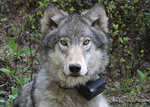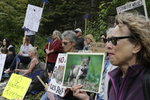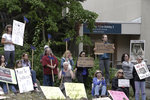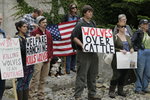




The ongoing wolf drama in Eastern Washington has put the Wolf Haven sanctuary squarely in the crosshairs of public opinion.
The Washington Department of Fish and Wildlife is currently in the midst of an effort to eradicate the Profanity Peak wolf pack in Ferry County after no less than 13 predation attacks on cattle have been attributed to the pack this summer. Efforts by the WDFW to eliminate the problem wolves began in early August after the department confirmed multiple wolf attacks on cattle. That initial lethal effort saw two wolves killed by gunfire from an overhead helicopter on Aug. 5. The WDFW maintained vigilance in the area for the next two weeks and then announced a halt to their wolf hunting efforts on Aug. 18, noting that no additional wolf attacks had been documented since their effort began.
However, the next day the WDFW announced that their action on the Profanity Peak pack would resume immediately after at least two instances of wolf predation on calves had been confirmed. This time around, though, instead of taking out presumed problem wolves the WDFW’s stated goal was to eliminate the Profanity Peak pack entirely.
In a state where agriculture pays many bills and a strong love of wildlife prevails, the WDFW’s choice to use the most extreme lethal option was certain to arouse strong feelings on both sides of the fence.
Four days after the WDFW announced their intention to kill the remaining members of the Profanity Peak wolf pack the renowned wolf sanctuary just outside of the south Thurston County town of Tenino known as Wolf Haven interjected itself directly into the line of fire.
In a press release signed by Wolf Haven, the Humane Society of the United States, Defenders of Wildlife and Conservation Northwest, the groups tried to defuse some of the tension by calling for open dialogue between disparate groups.
That press release read, in part; “The authorized removal of wolves in the Profanity Peak wolf pack in northeast Washington is deeply regrettable. The Washington Department of Fish and Wildlife (WDFW) is however following the protocol developed by the Washington State's Wolf Advisory Group (WAG) — a diverse group of stakeholders… In the meantime, we ask our community and the citizens of Washington State and beyond to engage in respectful and civil dialogue as we work through these challenging events. We believe that ultimately we can create conditions where everyone's values are respected and the needs of wildlife, wildlife advocates, and rural communities are met.”
The cooler-heads-prevail strategy proposed by Wolf Haven and their allies seemed to have little immediate impact though as both state wildlife officials and the rancher whose cattle have fallen at the fangs of wolves received death threats.
The heat turned up even more on Aug. 25 when a Washington State University professor specializing in large carnivores told The Seattle Times that he believed the rancher was at fault for turning out his cows directly on top of a known active wolf den. The WSU professor added that in his studies he has found that ranchers who follow WDFW protocol have not experienced cattle losses to wolves.
WSU has since disavowed the professor’s claims and rescinded his right to speak with the media, but the spark of controversy had already been added to a flammable atmosphere.
On Thursday, Sept. 2, one set of fervent voices descended upon the WDFW headquarters in Olympia in order to let their position be known. About 100 protesters showed up to that rally in what they described as a last-ditch effort to sway Gov. Jay Inslee to step in and end the killings.
Diane Gallegos, director of Wolf Haven, confirmed that there were even employees of Wolf Haven present at the rally, although she noted that they were in attendance as individual citizens only, without official affiliation with Wolf Haven.
“I don’t think anyone ever wants to see wolf puppies shot. That’s a hard thing,” said Gallegos.
Gallegos said she has been so busy answering inquiries from the media and general public that she’d nearly lost her voice by the night of the protest. She hypothesized that some of the attention focused on her organization has to do with the fact that Wolf Haven has been working on behalf of wolves in the region for so long. The rest of the attention, she admits, comes from the incongruity of a wolf sanctuary seemingly defending the state-authorized extermination of a wolf pack.
Gallegos said that each livestock producer grazing on public lands is given explicit details on how to operate on the land and said it is highly unlikely that a rancher would choose to sacrifice their animals to the whims of a wolf pack for either minimal state compensation or media fodder.
“They do what they do every year. They start them low and then move up as the grazing season progresses,” said Gallegos. “It’s not going to be uncommon for wolves and cattle to be right on top of each other.”
As a sitting member on the Wolf Advisory Group, Gallegos was a part of the process that created the lethal take option for wildlife managers as they attempt to juggle the conflicting worlds of wild and domesticated animals. Gallegos says that she is committed to have Wolf Haven at the table going forward as well.
She added that once threats started being lobbed in response to the wolf killings she felt compelled to come to the defense of the WDFW.
“I felt that statement was important because as a person of integrity I sat in that circle at the Wolf Advisory Group and I was given every opportunity to give input,” said Gallegos. “The director of Wolf Haven is never going to stand up and say, ‘Yes I support skilling wolves.’”
However, Gallegos said that she is compelled to support the thoughtful meeting of stakeholders and the subsequent group decisions.
“The difficulty is that wolves are new to Washington state after being absent for 80 years,” explained Gallegos. “They are coming into a state that is quite a bit different than it was all those years ago, and you have ranchers who are not used to dealing with wolves. Most ranchers won’t have a problem with wolves, but some of them will and that’s why we have compensation available.”
Gallegos said that studies have shown that only about 17 to 20 percent of wolves actively participate in livestock predation. She said the difference may be one of opportunity, or individual will, or that each family group has a distinct culture that is passed down from generation to generation. She also admitted that many wolf studies often wind up with conflicting data.
“Even agreed upon science is a hard thin with wolves right now,” admitted Gallegos. “We do know that avoiding a situation with predators is usually in everyone’s best interest,” since, “killing wolves can lead to further issues.”
Last February Wolf Haven took a wild female wolf from Pend Oreille County into their sanctuary after it was found cohabiting with a male guard dog that, ironically, had been charged with protecting livestock from said wolves. It was only the second displaced wolf from the wild that the sanctuary had ever accepted.
“We’d only taken one other wolf from the wild in and we agreed to take her in and try her out only because she was so comfortable around people,” explained Gallegos, who noted that Wolf Haven reserved the right to euthanize the wolf is she became a problem. So far that adopted wolf has been doing well at Wolf Haven but Gallegos says rehoming problem wolves from the wild is not a cure-all.
“It is not the answer to take these animals that are used to roaming around for miles and stick them in a kennel. It would make the people feel better but it would not be the best thing for the wolves,” explained Gallegos.
The Wolf Haven director did express some concern that the continuing conflict between wolves and livestock ranchers and the resulting state authorized wolf kills will set back the return of healthy wolf populations across Washington.
“I don’t want people to think that we aren’t terribly affected when we know that wolves have been killed. The pups are the same age as the red wolf pups that we have so we see these animals daily. It’s really hard for us to hear about them being killed,” said Gallegos.
“It’s not just the loss of the Profanity Peak pack and their breeding female. We’ve also lost several other packs and breeding females. I don’t know if that will set back the spread of wolves in Washington. They had estimated that by 2021 we’d be getting close to those recovery objectives and we’re still a ways off,” added Gallegos.
So instead of trying to adopt every wayward wolf in Washington, Gallegos says Wolf Haven will continue to walk the line and work toward a solution with the WDFW and all other assorted parties.
“I am completely committed to the wolf advisory group. I think the only way you can do this in a way that has a positive outcome is to have the various stakeholders at the table talking to one another. It’s hard and time consuming and sometimes it’s really difficult but developing that kind of trust in one another is what develops that space where problem solving can happen,” insisted Gallegos.
The next step in that process will be a pair of public meetings in Issaquah on Sept. 14-15. Gallegos expects that the meetings will consist of a rehashing of recent events from this grazing season, including the Profanity Peak situation. However, she does not believe that the lethal take protocol will wind up being discussed in detail until a public meeting in January. The location of that meeting has yet to be determined but Gallegos figures it will be in eastern Washington.
“It is sometimes hard to find the middle ground and I think that anytime with an issue like that you’ve got extremists that take purist’s’ stance on either side,” noted Gallegos. “Every action that humans take these days is going to have an impact on wildlife and the folks on either end I think help keep a balance, and help make sure the folks in the mushy middle are doing what they need to do.”
The latest update from the WDFW, posted on Sept. 2, noted that since the Profanity Peak extermination effort began on Aug. 20 one pup and three adult wolves have been killed, with the last kill taking place Aug. 22. Another dead calf was also attributed to the wolf pack on Aug. 31, bringing the Profanity Peak livestock toll up to 13 animals.
Diane Gallegos has been the director of Wolf Haven for 5 1/2 years and prefers to discuss nuanced issues like wolf management by phone. She can be reached at 360-264-4695, ext. 221.